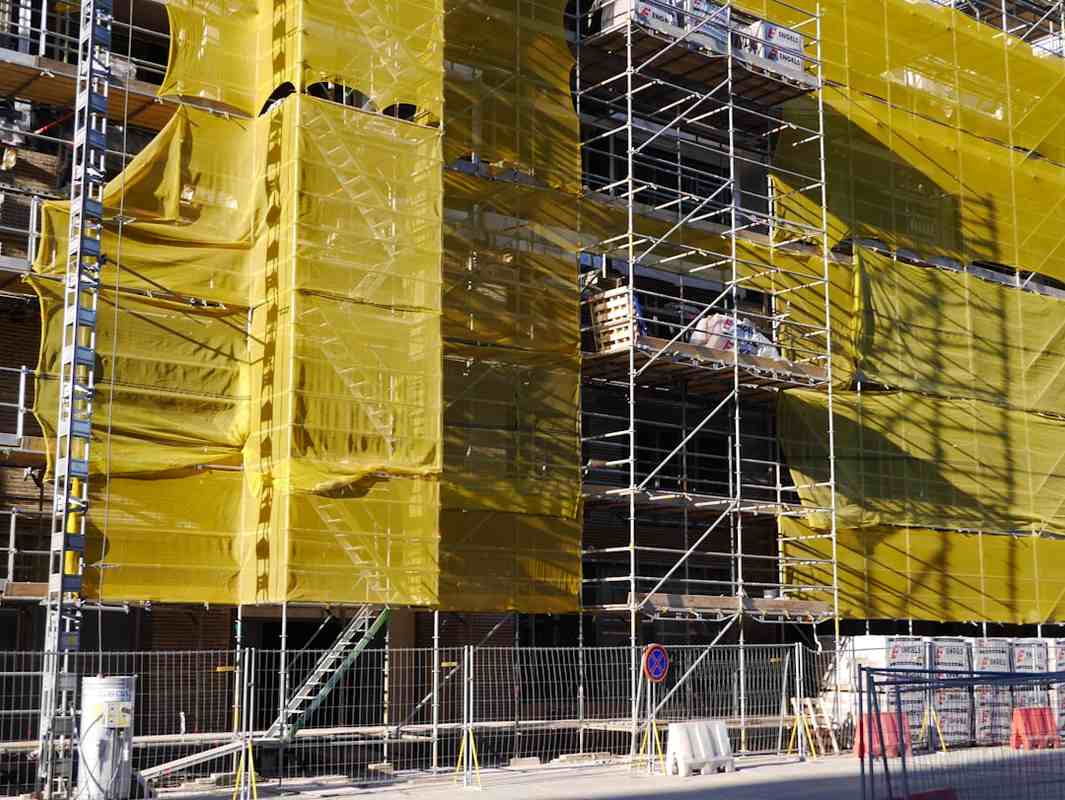(TEXAS) At least one in three construction contractors in Texas are reporting direct hits from stronger ICE enforcement this year, with company owners describing missing crews, stalled sites, and rising bills that ripple through local housing and public works.
Industry groups and on-the-ground supervisors say the stepped-up worksite actions—raids, audits, and tighter checks on employment eligibility—have turned a long-running labor squeeze into a breaking point since early 2025 under President Trump’s immigration agenda.

Immediate site impacts and workforce shortages
Executives across North Texas point to empty job trailers and half-staffed concrete pours. Alan Hoffmann of the Dallas Builders’ Association says North Texas faces a minimum 30% worker shortfall that he ties to ICE enforcement activity and fear of detention.
Contractors in other Texas metros report losing between one-third and one-half of their field labor—especially in framing, drywall, and roofing—on days following nearby ICE operations. The fallout is direct:
- Multi-week delays
- Cost overruns
- Mounting schedule penalties that owners now bake into bids
According to analysis by VisaVerge.com, wage pressure is amplifying the squeeze. Subcontracted immigrant workers—many with legal status, others without—are asking for “hazard pay.” Day rates that were $200–$300 last year now reach $400–$500 in some trades. Developers and public agencies ultimately shoulder those increases, raising costs for homebuyers and taxpayers.
Why Texas is especially exposed
The industry makeup makes Texas highly vulnerable:
- Roughly 40% of the state’s construction workforce is estimated to be foreign-born
- As many as 300,000 are thought to be undocumented
When ICE enforcement intensifies, the supply of skilled hands can shrink overnight. Site managers say even long-time, legally authorized Hispanic workers are staying home after raids because they fear racial profiling or being caught up in wide sweeps. That absenteeism worsens already severe labor shortages.
Project delays and cost spikes mirror national examples. One $20 million recreation center in Alabama—whose workforce profile resembles many Texas jobsites—lost half its crew after an ICE raid nearby. The project slipped three weeks and added $84,000 in unplanned costs. Texas superintendents describe the same pattern: first the jobsite thins out, then production drops, and finally the owner receives a change order for both time and money.
Quote / key takeaway
The pattern is consistent: crews scatter, production falls, and owners face change orders for both schedule and cost.
Enforcement acceleration and industry fallout
The Department of Homeland Security (DHS) has made worksite operations a priority, arguing enforcement protects public safety and fair competition. In 2025, the administration increased resources for immigration enforcement and detention, setting an ambitious removal goal over four years. DHS officials say employers must follow the law, keep complete records, and ensure only authorized workers are on payroll.
In Texas, the stepped-up approach appears mainly as:
- Notices of Inspection (NOIs) that kick off I-9 audits
- Physical worksite operations where ICE agents question workers, detain suspected immigration violators, and review records
When an employer receives an NOI, they generally have three business days to turn over Form I-9s, payroll records, and employee rosters. Trade groups warn that late or sloppy responses can trigger fines or referrals for further action.
Contractors report stark day-to-day effects:
- Crews scatter after word spreads of a raid, often via text
- Subcontractors scramble to replace missing teams or switch to smaller crews
- Weekend overtime becomes standard to recover lost time, increasing final invoices
The Associated General Contractors of America and the National Association of Home Builders argue that targeting entire worksites deepens the skilled labor gap. Their leaders, Jim Tobin and Brian Turmail, have urged the administration to focus on individuals with criminal records rather than broad sweeps that sideline authorized workers and stall major projects.
Broader economic signs
- Construction spending fell 3.5% through May 2025 after hitting a record high in May 2024—a rare drop outside recessions.
- In Texas, population growth and storm rebuilding maintain steady demand, but developers now face tighter timelines from lenders alongside a thinner workforce.
- City officials warn of slower delivery for schools, public safety buildings, and road upgrades, pressuring budgets and complicating bond plans.
Compliance steps and legal boundaries
With ICE enforcement rising, contractors are tightening compliance systems. Attorneys in Texas report two to three new inquiries a day from employers seeking advice on I-9 audits, subcontractor oversight, and handling site visits. The National Association of Home Builders has circulated updated guidance—“When ICE Comes Calling”—that outlines management roles, document control, and communications protocols.
Key steps shared by labor counsel and trade groups include:
- Keep complete, accurate Form I-9 files for every employee and conduct regular internal audits.
- Use the latest version and fix technical errors quickly.
- Link for reference: Form I-9 Employment Eligibility Verification
- Train front-office staff and site supervisors on how to respond to government visits.
- Escalate all requests immediately to senior management or legal counsel.
- Verify that subcontractors meet I-9 duties for their employees.
- Prime contractors can face exposure if subs ignore the rules.
- If ICE serves an NOI, gather and submit requested documents within three business days and track delivery.
- During worksite operations, remember agents may enter public areas; entry into non-public spaces generally requires a judicial warrant signed by a judge.
- Administrative warrants (often labeled Form I-200 or Form I-205) do not grant permission to enter non-public areas or seize records without consent.
- Supervisors should ask to see any warrant and contact counsel immediately.
Contractors also face limits of current tools. Many firms use E-Verify, but industry officials say forged identity documents remain common. That means diligent employers can still be tripped up if documents appear valid on their face but are fraudulent. Counsel advise training HR staff on document review standards and avoiding both over-documentation and discrimination.
For quick reference on employer duties and enforcement scope, see ICE’s official worksite guidance: Worksite Enforcement. The agency explains audits, fines, and what employers should expect during inspections.
While the rules are clear on paper, firms say the real stress comes when crews scatter and schedules slip in the days after an operation.
Policy signals and industry responses
Washington’s policy signals suggest pressure will continue. The administration says worksite enforcement is central to restoring the rule of law. It has also:
- Promoted apprenticeship programs
- Created a Labor Department Office of Immigration Policy with a brief to streamline temporary work visas
Business groups welcome those steps but argue they won’t quickly replace the large share of foreign-born tradespeople Texas depends on. Their preferred fix—temporary legal status for vetted, experienced workers already here—faces resistance in Congress, where key Republicans reject moves they view as amnesty.
On-the-ground decision points
In the field, decisions happen hour by hour:
- A general contractor must decide whether to pause a concrete pour if half the finishing crew is missing.
- A roofing subcontractor may offer hazard pay to keep a team that wants cash upfront.
- A superintendent chooses whether to open a locked storage area when agents present an administrative warrant.
Each decision carries cost, legal exposure, and human consequences.
The human side
Many workers are parents who have spent years on Texas jobsites—some with lawful status, others seeking it. When a raid occurs nearby, they weigh a day’s pay against the chance of being detained far from their children. Foremen describe honest conversations with crew members who say they’re “staying home for a week ‘to be safe.’” Even short pauses create chain reactions across inspections, pours, and deliveries that can set a project back weeks.
How contractors are adapting
Most Texas construction contractors are moving on two tracks:
- Hardening compliance: investing in I-9 systems, staff training, and clear protocols
- Redesigning schedules: coping with thinner crews by carving scopes into smaller packages, extending durations on bids, and adding contingency lines for overtime and replacements
On public jobs, time extensions are becoming a standard ask.
Looking ahead, industry leaders generally expect ICE enforcement to remain strong through 2025 and beyond. Without a new worker pipeline or a legal bridge for experienced tradespeople, Texas faces a cycle of:
- Labor shortages
- Higher wages
- Slower builds
That combination raises costs for homeowners, businesses, and city governments—especially in fast-growing North Texas, which is heavily reliant on immigrant labor.
VisaVerge.com reports that trade associations will keep pressing for balanced solutions: strong compliance paired with lawful work options that match the field’s needs. For now, Texas jobsite trailers carry laminated checklists next to hardhat rules:
- Lock the office
- Call counsel
- Verify the warrant
- Keep the I-9 binder ready
Those steps may not solve the labor crunch, but they can help firms get through the next visit—and keep the cranes moving, even if more slowly than anyone wants.
This Article in a Nutshell
Intensified ICE worksite enforcement in 2025 has materially disrupted Texas construction, producing immediate labor shortages, stalled projects, and higher costs. Industry groups report North Texas shortages of at least 30%, with many jobsites losing between one-third and one-half of field labor after nearby operations. The disruption causes multi-week delays, cost overruns, and schedule penalties; day rates for some trades have doubled as workers demand hazard pay. Contractors respond by strengthening I-9 compliance, training staff, documenting records, and redesigning schedules to include contingencies. Federal actions typically begin with Notices of Inspection that require three business days to produce I-9s and payroll records. Legal counsel advises verifying warrants, submitting timely documentation, and auditing subcontractor compliance. Absent new worker pathways or rapid policy changes, industry leaders expect continued shortages, higher wages, and slower building timelines, raising costs for homebuyers and public projects.












